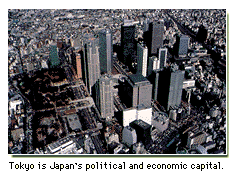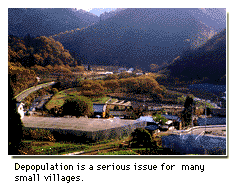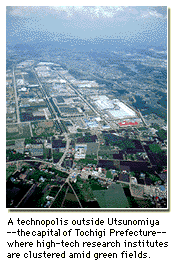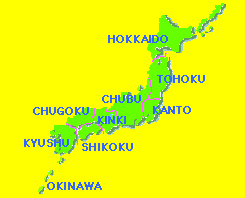 There are 47 prefectural and over 3,300 municipal governments in Japan. Their responsibilities include providing education, welfare and other services, and infrastructure, including utilities. Their administrative activities bring them into close contact with the local people.
There are 47 prefectural and over 3,300 municipal governments in Japan. Their responsibilities include providing education, welfare and other services, and infrastructure, including utilities. Their administrative activities bring them into close contact with the local people.
Within Japan, climate and natural features differ widely from region to region. And regions differ in their history and culture, too.
 Tokyo, the nation's capital, is the political and economic center of Japan. It is also the most populous part of the country; nearly one quarter of the Japanese--around 30 million people--live within 50 kilometers of Tokyo.
Tokyo, the nation's capital, is the political and economic center of Japan. It is also the most populous part of the country; nearly one quarter of the Japanese--around 30 million people--live within 50 kilometers of Tokyo.
The heavy concentration of people in urban areas has produced many problems, such as cramped living space and congested roads and trains. Nonetheless, many young people from small villages and towns continue to flock to urban areas to look for work, and rural populations are falling.
 Efforts are being made to revive rural areas through active use of transportation and information networks. As an example of regional development, a total of 26 areas have been designated as new types of industrial communities called "technopolises"--integrated centers for high-tech industries, universities, research institutes, and other facilities for research into cutting-edge technologies.
Efforts are being made to revive rural areas through active use of transportation and information networks. As an example of regional development, a total of 26 areas have been designated as new types of industrial communities called "technopolises"--integrated centers for high-tech industries, universities, research institutes, and other facilities for research into cutting-edge technologies.
Photos courtesy of Tokyo Metropolitan Government and Ministry of International Trade and Industry.


 There are 47 prefectural and over 3,300 municipal governments in Japan. Their responsibilities include providing education, welfare and other services, and infrastructure, including utilities. Their administrative activities bring them into close contact with the local people.
There are 47 prefectural and over 3,300 municipal governments in Japan. Their responsibilities include providing education, welfare and other services, and infrastructure, including utilities. Their administrative activities bring them into close contact with the local people.

 Tokyo, the nation's capital, is the political and economic center of Japan. It is also the most populous part of the country; nearly one quarter of the Japanese--around 30 million people--live within 50 kilometers of Tokyo.
Tokyo, the nation's capital, is the political and economic center of Japan. It is also the most populous part of the country; nearly one quarter of the Japanese--around 30 million people--live within 50 kilometers of Tokyo.
 Efforts are being made to revive rural areas through active use of transportation and information networks. As an example of regional development, a total of 26 areas have been designated as new types of industrial communities called "technopolises"--integrated centers for high-tech industries, universities, research institutes, and other facilities for research into cutting-edge technologies.
Efforts are being made to revive rural areas through active use of transportation and information networks. As an example of regional development, a total of 26 areas have been designated as new types of industrial communities called "technopolises"--integrated centers for high-tech industries, universities, research institutes, and other facilities for research into cutting-edge technologies.

